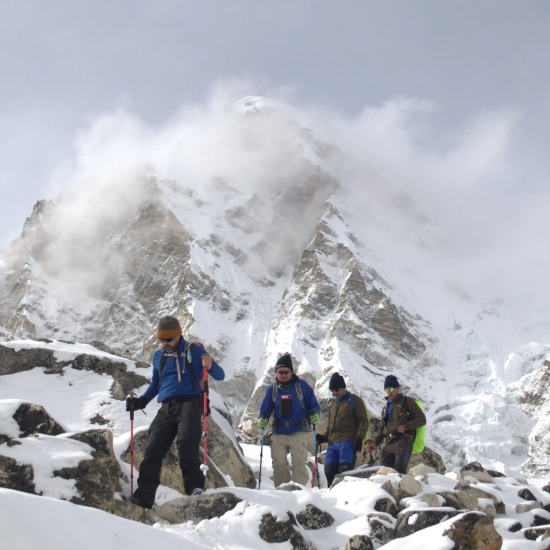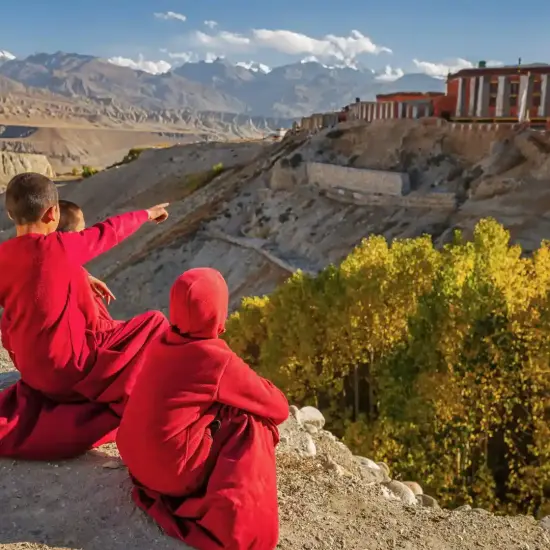Get ready for an unforgettable journey that blends two of Nepal’s most legendary trekking routes — the iconic Everest Base Camp (5,364m/17,598ft) and the magical Gokyo Lakes (4,700–5,000m/15,400–16,400ft). This adventure is a dream come true for anyone looking to challenge themselves, witness breathtaking landscapes, and dive deep into the vibrant Sherpa culture of the Khumbu region.
What to Expect on the Gokyo Lakes with EBC Trek
This isn’t just a trek — it’s a full-blown adventure packed with jaw-dropping moments and heart-pounding achievements. If you're seeking something tougher, wilder, and more rewarding than the standard EBC trek, this is it.
Here’s a taste of what’s waiting for you:
Trekking through classic Himalayan landscapes, from lush valleys to glacial moraines
Admiring the mirror-like waters of Gokyo Lake (4,790m/15,715ft), tucked under snowy giants
Summiting incredible viewpoints like Kala Patthar (5,550m/18,204ft), Cho La Pass (5,420m/17,782ft), and Gokyo Ri (5,357m/17,575ft) for sunrises that will stay with you forever
Pushing your limits, crossing the thrilling Cho La Pass
Soaking up the rich Sherpa traditions in villages like Namche Bazaar (3,440m/11,286ft), Dingboche (4,410m/14,468ft), and Machhermo (4,470m/14,665ft)
Stopping by the world's highest Irish pub at Namche Bazaar — yes, it exists!
Savoring warm, home-cooked meals in cozy teahouses, offering a true glimpse into mountain life
Enjoying epic views of Everest (8,848.86m/29,031.7ft), Lhotse (8,516m/27,940ft), Makalu (8,481m/27,825ft), and Cho Oyu (8,188m/26,864ft)
And who knows? Along the way, you might even spot a Himalayan Thar, colorful Danphe pheasants, or a shy snow leopard if you're lucky!
Your Trekking Journey: Step-by-Step
This circular trek is designed so you don’t retrace your steps, giving you new scenery almost every day. It's a bit more physically demanding than the standard Everest Base Camp route because of higher altitudes and technical sections like Cho La Pass — but every challenge comes with a big reward.
Here’s how your journey unfolds:
Day 1: Fly to Lukla (2,860m / 9,383ft) and Trek to Phakding (2,650m / 8,694ft)
Your adventure kicks off with a scenic flight from Kathmandu or Manthali to Lukla, one of the world's most thrilling airports. Upon arrival, we hit the trail, descending gradually to the beautiful riverside village of Phakding.
Day 2: Trek from Phakding to Namche Bazaar (3,440m / 11,285ft)
Following the Dudh Koshi River, we cross suspension bridges draped in prayer flags and ascend towards Namche Bazaar, the bustling heart of the Khumbu Region.
Day 3: Acclimatization Day at Namche Bazaar
Today’s a rest day — but not without a little adventure! We’ll take a short hike to the Hotel Everest View (3,880m / 12,729ft) for stunning vistas of Everest and surrounding giants. This helps our bodies adjust to the altitude.
Day 4: Trek from Namche Bazaar to Tengboche/Deboche (3,855m / 12,850ft)
We trek through rhododendron forests with sensational views of Everest, Lhotse, and Ama Dablam, finally reaching the spiritual hub of Tengboche Monastery. We'll stay either here or slightly downhill in the peaceful hamlet of Deboche.
Day 5: Trek from Deboche/Tengboche to Dingboche (4,360m / 14,290ft)
Today, we hike through charming Sherpa villages and past ancient mani walls before ascending to Dingboche, where the wide valley opens up beautifully beneath soaring peaks.
Day 6: Acclimatization Day at Dingboche – Day Hike to Chukhung Valley (4,730m / 15,518ft)
Another important acclimatization day! We’ll venture into the stunning Chukhung Valley, getting up close to Lhotse and Island Peak, then return to Dingboche to rest and enjoy warm Sherpa hospitality.
Day 7: Trek from Dingboche to Lobuche (4,930m / 16,175ft)
As we climb higher, the landscape becomes more rugged and glacial. We pass through Dughla, with moving memorials to lost climbers, before reaching Lobuche, tucked under the giant Khumbu Glacier.
Day 8: Trek from Lobuche to Everest Base Camp (5,364m / 17,598ft), Return to Gorak Shep (5,185m / 17,010ft)
Big day ahead! We push to Everest Base Camp itself — standing where mountaineers begin their summit dreams — then trek back to the small settlement of Gorak Shep for the night.
Day 9: Hike from Gorak Shep to Kala Patthar (5,550m / 18,204ft), Trek to Dzongla (4,830m / 15,846ft)
Catch the unforgettable sunrise over Everest from Kala Patthar, one of the best viewpoints in Nepal. After soaking in the views, we descend and trek onward to the quiet village of Dzongla.
Day 10: Cross Cho La Pass (5,420m / 17,782ft), Trek to Dragnag (4,700m / 15,419ft)
An adventurous day awaits! Crossing the icy and thrilling Cho La Pass is challenging but incredibly rewarding. After the pass, we descend into the rocky village of Dragnag.
Day 11: Trek from Dragnag to Gokyo (4,750m / 15,583ft)
We traverse the mighty Ngozumpa Glacier — Nepal’s longest — to reach the mesmerizing turquoise waters of Gokyo Lakes. Prepare to fall in love with the scenery here!
Day 12: Summit Gokyo Ri (5,357m / 17,575ft) and Trek Down to Dole (4,040m / 13,255ft)
An early morning climb to Gokyo Ri rewards you with panoramic views of Everest, Lhotse, Makalu, and Cho Oyu. After soaking it all in, we trek downhill through yak pastures to Dole.
Day 13: Trek from Dole to Namche Bazaar (3,440m / 11,286ft)
We continue descending through rhododendron and pine forests, passing small Sherpa settlements on our return to the colorful and lively Namche Bazaar.
Day 14: Trek from Namche Bazaar to Lukla (2,860m / 9,383ft)
Retracing our steps along the Dudh Koshi River, we descend steadily back to Lukla, feeling a mix of triumph and nostalgia for the journey we've just completed.
Day 15: Fly back to Kathmandu/Manthali from Lukla (2,860m / 9,383ft)
After an early breakfast, we catch a scenic flight back to Kathmandu or Manthali. Time to celebrate your incredible achievement and reflect on a lifetime adventure in the Himalayas!
Clockwise vs. Anticlockwise: Choose Your Adventure
You can trek this route either clockwise or anticlockwise. Both ways are equally spectacular, but clockwise (starting towards Gokyo first) can sometimes help with a slightly easier acclimatization flow.
Either way, you’ll:
Experience life at remote Sherpa villages like Machhermo (4,470m/14,665ft) and Dole (4,200m/13,780ft)
Cross glaciers, high passes, and emerald lakes
Stand proudly at Everest Base Camp after days of challenge and reward
Catch sunrises you’ll never forget at Kala Patthar and Gokyo Ri
The Gokyo Lake via Everest Base Camp trek is a grand Himalayan circuit that promises adventure, culture, and personal triumph at every turn. Whether it's sunrise from Kala Patthar or the turquoise magic of Gokyo Lakes, this journey is a memory for life.










-webp.webp) Trek Permit Required
Trek Permit Required 
























































